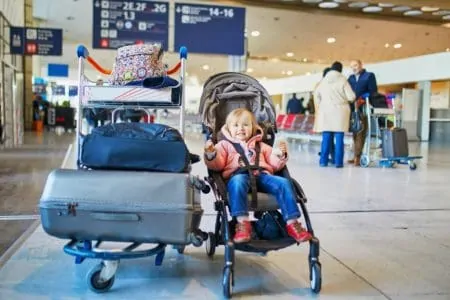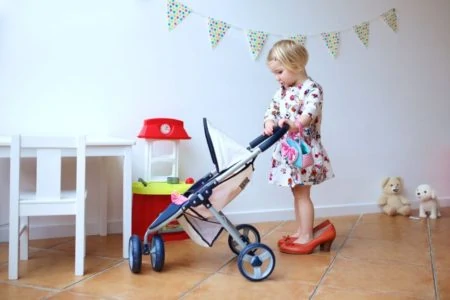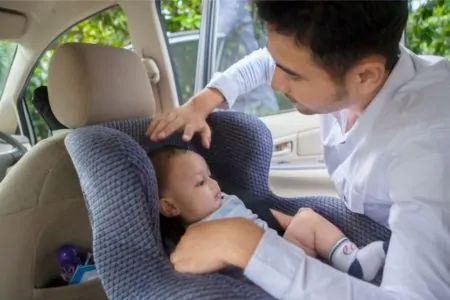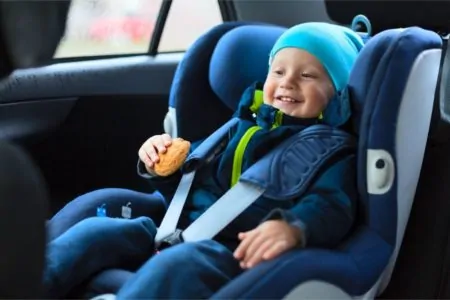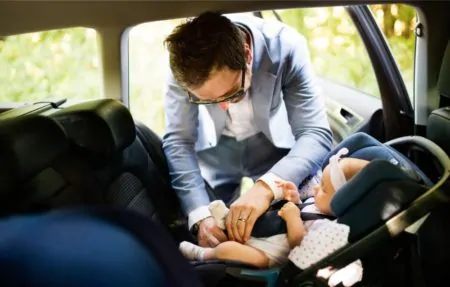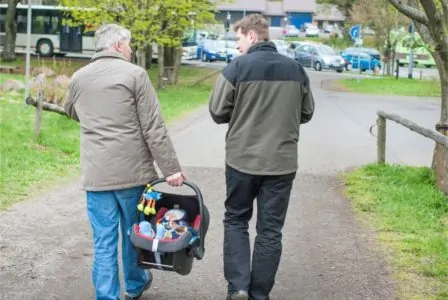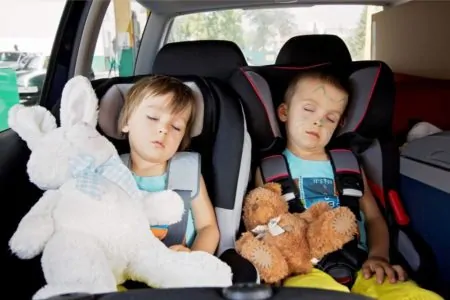Flying with car seats and strollers often feels like a high-stakes juggling act. We know the feeling; we have navigated chaotic terminals with toddlers and gear more times than we can count. To complicate matters, rules seem to shift depending on the airline, the airport, or even the mood of the gate agent.
So, is it worth hauling the bulky equipment, or should you rent at your destination? We will break down the regulations, share our personal travel hacks, and highlight expert safety recommendations to help you fly with confidence.
Key Takeaways
- Flying with your own car seat is the safest option and protects against turbulence or runway incidents.
- Car seats must be FAA-approved to be used on board; strollers usually need to be gate-checked unless they fit in the overhead bin.
- Invest in a protective travel bag to prevent grease, dirt, and damage to your expensive gear.
- Always have a backup plan for transportation at your destination in case your equipment is lost or damaged.
Why Fly With a Car Seat and Stroller?
You might wonder if dragging your car seat and stroller through security is worth the effort. While it is ultimately a parental choice, the American Academy of Pediatrics (AAP) strongly recommends using a child restraint system during flights (1). The Federal Aviation Administration (FAA) echoes this recommendation, though they do not currently mandate it by law (2).
A Car Seat Protects Your Child In Flight
Many parents assume that because the FAA allows children under 2 to fly as “lap children,” it must be safe. Unfortunately, physics tells a different story.
Crash investigations and safety data indicate that lap children are vulnerable to serious injuries during turbulence or runway incidents (3). It is physically impossible for an adult to hold onto a child during severe turbulence or a sudden stop.
Crash tests consistently show that children restrained in an FAA-approved car seat are significantly more likely to survive and avoid injury compared to unrestrained lap children.
Car Seats Provide Comfort on the Airplane
Flying is disrupting enough for a routine-loving toddler. Strapping them into their familiar car seat can provide a sense of normalcy and security.
It is also much more comfortable for you. Instead of having a squirming, heavy toddler on your lap for four hours, you can actually have your hands free to eat a snack or read a book.
Safer Than Car Seats and Strollers at Your Destination
Some parents prefer to rent gear upon arrival to travel light. While convenient, this approach has significant safety drawbacks.
- Availability is not guaranteed: Rental agencies run out of stock, leaving you stranded without a safe way to transport your child.
- Unknown history: You cannot verify if a rental car seat has been in a crash, washed with harsh chemicals, or expired.
- Hygiene concerns: Even with domestic travel, you have no assurance that the equipment has been properly sanitized or maintained to the standards you expect at home.
The Best Car Seats and Strollers for Flying
Choosing the right gear can make the difference between a smooth trip and a airport meltdown. The biggest mistake I made was thinking my massive everyday “travel system” was suitable for air travel. It wasn’t.
Our standard travel system was great for the grocery store, but folding it in a jet bridge while a line of passengers waited behind me was a nightmare. We quickly learned that a dedicated lightweight stroller is essential.
The catch with many lightweight strollers is that they often don’t recline fully, making them unsuitable for newborns. You generally need a stroller that accepts an infant bucket seat or lies flat until your baby can sit up independently.
After extensive testing, we chose the Mountain Buggy Nano Duo Stroller. It is infant car seat ready, meaning we could click our newborns straight in without waking them. Crucially, it folds compact enough to fit in many overhead bins. This allowed us to skip the gate-check wait and walk right off the plane with our gear in hand.
For the car seat itself, fit is everything. We opted for the Chico KeyFit 30. It is relatively narrow and lightweight, which matters when you are hauling it through a sprawling terminal like O’Hare or Atlanta. When buying a seat for travel, look for a narrow base (under 17 inches is ideal) to ensure it fits comfortably within the cramped economy seats.
How to Check a Car Seat or Stroller
Navigating the logistics of checking gear is easier than it looks. You generally have two options: checking it at the ticket counter with your suitcases, or checking it at the gate right before you board.
Regardless of where you check it, remove all accessories. Cup holders, snack trays, and dangling toys will almost certainly get snapped off by baggage machinery. Secure all dangling straps to prevent them from getting caught in conveyor belts.
At the Ticket Counter or Curbside
This is the “hands-free” option. You hand over your stroller and car seat when you get your boarding pass.
- Tell the agent you are checking baby gear.
- Most airlines check these items for free and they do not count toward your baggage allowance.
- Ensure they tag it to your final destination.
At the Gate
This is the most popular option because you can use your stroller all the way through the airport.
- Get your tag early: Do not wait until boarding starts. As soon as you arrive at your gate, go to the podium and ask for a “Gate Check” tag.
- Attach it securely: Put the tag on the stroller handle or car seat handle immediately.
- Fold and drop: When you board, fold the stroller and leave it at the end of the jet bridge (or the designated drop zone).
We once delayed a flight because we waited until we were scanning our tickets to ask for a tag, and the agent had run out. It took 20 minutes to find one. Learn from our mistake and get tagged early.
Can I Bring My Car Seat or Stroller as a Carry-On?
Yes, but size matters. A stroller can only be a carry-on if it folds small enough to fit in the overhead bin (like the Babyzen Yoyo or GB Pockit). If it doesn’t fit, it must be gate-checked.
You can bring a car seat on board only if you have purchased a separate ticket for your child. You cannot bring a car seat on board to store in the overhead bin; it is too large and must be used in a seat or checked.
How to Protect a Stroller or Car Seat When Flying
Baggage handlers are focused on speed, not gentleness. Your gear will be tossed, stacked, and exposed to the elements.
If you have a lightweight stroller, consider the Alnoor USA Flight Check Bag. While it won’t stop a crushing force, it protects against grease, rain, and scuffs. The backpack straps are a lifesaver when you need hands free for passports and boarding passes.
For car seats, protection is vital. If you check your seat, we recommend the JL Childress Check Bag for basic dirt protection. However, if you want to minimize the risk of cracks or structural damage, invest in the JL Childress Padded Car Seat Bag. It acts like a padded cocoon and makes the seat easier to carry.
Using a Car Seat on the Plane
Using your car seat on board requires a bit of prep. First, ensure your seat is FAA-approved. Look for a sticker on the side of the seat that says roughly: “This restraint is certified for use in motor vehicles and aircraft.”
Flight attendants are trained to look for this sticker. If you cannot show it, they may force you to check the seat.
Seat Placement Rules
You cannot place a car seat just anywhere.
- No Emergency Rows: Car seats are never allowed in exit rows or the rows immediately before/after them.
- Window Seats Preferred: A car seat must not block the egress of another passenger. This usually means it goes in the window seat.
- Middle Seats: In a wide-body plane with a center section, a car seat can go in the middle seat, provided it doesn’t block anyone from getting to the aisle.
Installation Tips
Install your car seat according to the manufacturer’s instructions. Airplane belts function differently than car belts; you simply thread the lap belt through the belt path and pull it tight.
If you are using a rear-facing infant seat, keep it rear-facing on the plane. Occasionally, a flight attendant may ask you to turn it forward because of the person reclining in front of you. Kindly show them the FAA guidance or your manual which states the seat must be used as designed (4).
If a conflict arises, stay calm. Ask for a lead flight attendant or a complaint resolution official (CRO) if necessary, but ultimately, you must follow crew instructions to remain on the flight.
Other Tips for Flying with Car Seats and Strollers
After logging thousands of miles with toddlers, here are a few extra tips to save your sanity.
- Measure twice: If you plan to bring a stroller on board, check the specific airline’s carry-on dimensions. What flies on Delta might not fly on Spirit.
- Know the pickup point: Ask the gate agent where you will get your stroller back. Usually, it is on the jet bridge upon landing, but for strollers checked at the counter, it might be at the oversized baggage claim carousel.
- Wear the baby: Bring a baby sling or carrier. If you have to check your stroller, a carrier allows you to navigate the airport hands-free.
- Take photos: Photograph your gear right before you hand it over. If the airline damages it, time-stamped photos are your best evidence for a claim.
- Have a Plan B: Research rental companies or taxi services with car seats at your destination, just in case your gear gets lost in transit.
